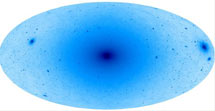
Handy Links
SLAC News Center
SLAC Today
- Subscribe
- Archives: Feb 2006-May 20, 2011
- Archives: May 23, 2011 and later
- Submit Feedback or Story Ideas
- About SLAC Today
SLAC News
Lab News
- Interactions
- Lightsources.org
- ILC NewsLine
- Int'l Science Grid This Week
- Fermilab Today
- Berkeley Lab News
- @brookhaven TODAY
- DOE Pulse
- CERN Courier
- DESY inForm
- US / LHC
SLAC Links
- Emergency
- Safety
- Policy Repository
- Site Entry Form

- Site Maps
- M & O Review
- Computing Status & Calendar
- SLAC Colloquium
- SLACspeak
- SLACspace
- SLAC Logo
- Café Menu
- Flea Market
- Web E-mail
- Marguerite Shuttle
- Discount Commuter Passes
-
Award Reporting Form
- SPIRES
- SciDoc
- Activity Groups
- Library
Stanford
Around the Bay
Dark Matter May Be Brighter Than Expected

The Fermi Gamma-ray Space Telescope might be able to find dark matter in our galaxy, and soon, if new predictions prove true. Theoreticians have demonstrated that small clumps of dark matter in our galaxy and others like it may be more visible than previously thought. Dark matter particles orbiting within self-bound clumps tend to move slower than those bound only to the larger halo that wraps around the entire galaxy. As a result, these smaller halos may generate a higher flux of gamma rays. If the theory is on target, the Fermi telescope could detect hundreds of small dark matter halos in the Milky Way alone. But, according to the authors of the paper in this week's Science, even a negative result will move the work forward.
Researchers are still uncertain exactly what dark matter is, but a predominant theory suggests it is made up of supersymmetric particles that act as their own anti-particles. While dark matter does not emit or reflect light, the subatomic particles can annihilate each other—leaving behind a wreckage of subatomic detritus that may subsequently decay into gamma rays and reveal the location of the otherwise invisible matter.
In 2008, theoretical physicist Michael Kuhlen and his collaborators in the Via Lactea Project ran a complex computer simulation of dark matter behavior in a galaxy like the Milky Way. Many researchers use simulations like this one; most of the work lies in finding different ways to analyze what the simulation spits out. Kuhlen's first analysis showed that only a handful of small dark matter clusters, or halos, would be visible by the Fermi telescope. But more recently, Kuhlen took another look at the results and applied what is known as the Sommerfeld effect. This takes into account the relative velocities of dark matter particles within the larger structure. The Sommerfeld effect is well known in nuclear physics and commonly observed in experiments. But it's relevance for dark matter annihilation was not appreciated until recently and this is the first time it has been applied to a dark matter simulation. Kuhlen, who is now at The Institute for Advanced Study in Princeton, and collaborators Piero Madau of UC Santa Cruz and Joseph Silk of Oxford, used the Sommerfeld effect to show that slower moving dark matter particles, like those in small halos, will have higher rates of annihilation and subsequently high gamma ray flux. Rather than a handful of small dark matter clusters, Fermi could see hundreds.
But it's been a year since data collection began and Fermi hasn't seen any dark matter yet. "So that immediately starts putting constraints on testing Sommerfeld enhanced models," said Kuhlen. Because scientists don't fully understand dark matter, there are multiple models exhibiting Sommerfeld enhancement, and the group considered more than one in their paper. But Kuhlen is also considering the impact of his paper from this converse side: it's more likely the simulation results will rule out some of these models by testing them against observations.
"Of course it would be tremendously exciting if Fermi did discover hundreds of sub-halos, and provided strong evidence for one of these models," he said. "But I think the true power is…that a lot of these models will be strongly contrained if Fermi actually does not detect any sub-halos or only detects a few. And that's maybe not as exciting as actually detecting a signal, but in terms of science and research it's progress."
—Calla Cofield
SLAC Today, July 17, 2009